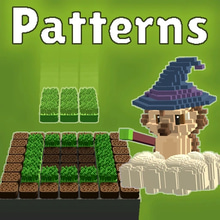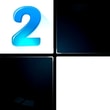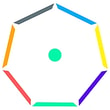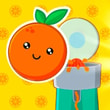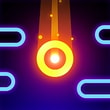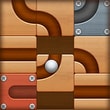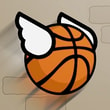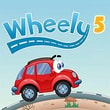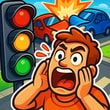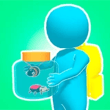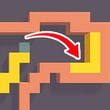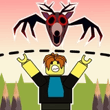The first board looks like a postcard from a math museum: clean dots, tidy lines, a quiet silhouette waiting to be completed. You press, the line glides, and a simple triangle snaps into place with a soft chime that feels like a door quietly opening in your head. Patterns is exactly what its name promises and a little more—an elegant logic puzzle that teaches your eyes to listen, your hands to think, and your stress to sit down for a minute. No countdowns barking orders. No gimmicks shouting for attention. Just shapes, symmetry, and that delicious “aha” when the last segment clicks.
🧩 Tiny shapes, big ideas
At heart, you’re reconstructing designs on a grid—sometimes by connecting dots, sometimes by rotating tiles, sometimes by placing mirrored pieces without breaking the negative space. Early levels are sweet and generous: draw a square, mirror a zigzag, rotate a fan of triangles until it matches the ghost image in the corner. Then the game starts whispering: can you see the hidden axis? Can you build the whole with only half the blueprint? Can you complete the motif while obeying one rude rule—no overlaps, no crossings, no strays? It’s not about speed. It’s about seeing the picture beneath the picture.
🪞 Symmetry school (that never feels like school)
Horizontal, vertical, radial—Patterns speaks symmetry like a friendly tutor who prefers jokes to lectures. A snowflake level shows six spokes but only lets you move one; turn it, and the rest follow like well-behaved echoes. A butterfly board hides its true axis a peg to the left of center; when you find it, both wings resolve and the whole screen sighs with relief. Rotational puzzles are little dances: 90°, 180°, 120° if you’re feeling fancy. By the time kaleidoscope stages arrive, your thumbs already know the rhythm—nudge, compare, nudge, confirm.
🧠 The comfort of constraint
Rules are lane lines, not fences. One mode forbids overlapping segments, so you route like a considerate architect. Another asks you to cover every cell exactly once, turning the board into a neat Hamiltonian stroll. Color-lock stages insist blue touches blue, red avoids red, and yellow bridges arguments like a diplomat with good snacks. These constraints don’t strangle; they sculpt. Each restriction trims chaos until only the clean answer remains, and when you find it, the satisfaction is surgical.
🎨 Minimalist vibe, maximum clarity
Patterns understands that the best puzzle UI stays out of the way. The palette is calm—paper white, graphite gray, a few confident accent colors. Lines glow when valid, dim when dubious. Ghost images fade as you approach correctness, a subtle pat on the back that keeps your momentum warm. There’s no glittery confetti explosion at the end—just a gentle bloom, a soft chord, and a new board sliding in like a fresh page. It feels grown-up without being grim, cozy without being sleepy.
🧲 Tools that feel like toys
You get a handful of verbs and they’re all tactile. Drag to draw lines that snap neatly to pegs. Twist tiles with a satisfying flick that lands on discrete angles—no fiddly micro-rotations, just confident clicks. Flip pieces along an axis with a quick tap-tap; the animation sells weight without wasting time. A temporary pin lets you lock an anchor while you experiment, and an “ink undo” peels your last move back in one graceful ribbon. Hints exist, but they’re polite: highlight a likely axis, whisper the next rotation, never bulldoze the joy of discovery.
⏳ Play your pace (and your mood)
Patterns comes with modes for the brain you brought today. In Classic, you solve at leisure—sipping tea, counting lines, ignoring time. Challenge adds gentle clocks and move limits that reward planning without punishing curiosity. Mirror Marathon strings symmetry boards into a meditative flow where each solution teaches the next. Daily Mosaic drops a new handcrafted design every day—seasonal sketches, abstract glyphs, and the occasional cheeky animal silhouette—perfect for a morning coffee win. However you play, restarts are instant and “just one more” turns into “okay, three more” before you notice.
🎧 Sound you can think inside
This is a headphones-welcome game. The music leans soft and modern—piano plinks, hushed pads, a beat that remembers to breathe. Interaction sounds do quiet work: lines “tick” when they align, tiles “thock” when they settle, flips “woop” with a miniature whoosh that would make a foley artist proud. As boards grow richer, the soundtrack recedes a touch, letting tactile cues carry the conversation. You’ll find yourself solving by ear—waiting for that confident click before moving on—and that’s exactly how a good puzzle should feel.
🧭 Gentle on-ramp, honest curve
The first dozen levels teach without text—one new idea at a time, woven into boards that feel like friendly riddles. Mid-game stacks mechanics: draw under/over rules, selective fill, rotational locks that free only after you fix the neighbors. Late-game turns nuance into poetry: fill the negative space to conjure the positive, use symmetry to reduce complexity, solve half to complete all. Nothing is cheap. Everything is readable. If you’re stuck, the solution is always legible in hindsight, which makes learning stick for the next board.
🌟 Style, mastery, and little flexes
Clearing a level is good. Clearing it elegantly is better. Patterns quietly tracks efficiency—fewest moves, minimal rotations, cleanest path—and sprinkles tiny laurels when you nail all three. You’ll replay favorites to shave a step, discover a smarter axis, or route a line that looks like calligraphy. Cosmetic themes unlock as you progress: blueprint mode with crisp cyan lines, charcoal sketch with paper grain, night neon where shapes glow like club signage. None of it changes difficulty; all of it changes mood.
🧠 Micro-tips you’ll pretend you discovered
Find the odd peg out; axes often anchor there. When a ghost image looks messy, blur your eyes—large structure reveals itself when detail retreats. Place the biggest piece first; small pieces are patchwork, not foundation. If two constraints argue, invert the board—rotate your view or flip the mental axis; stalemates melt when perspective shifts. On “one-stroke” puzzles, avoid early corners; reserve them for closures. And when frustration knocks, walk away for sixty seconds; your first glance back tends to land straight on the answer.
🖼️ Why this loop feels different
Patterns doesn’t measure worth in panic. It measures it in clarity. Ten minutes yields three satisfying solves and a calmer brain; an hour leaves you with a stack of small, honest victories that feel earned in your fingers. It respects curiosity, rewards restraint, and turns geometry into a conversation you can actually win. On Kiz10, it’s an ideal “just-a-bit” game that keeps becoming a ritual—one board with breakfast, one before bed, a few at lunch when your day needs neatness. Shapes become sentences. Your solutions become signatures.
SEO spark and replay fuel
Because the design is minimalist and the mechanics are clear, Patterns loads fast, looks crisp on any screen, and invites repeat visits with Daily Mosaic and efficiency medals. It’s content you can feel improving at—great for leaderboards, better for the quiet satisfaction of a brain that untangles itself while you draw lines that make sense. If puzzle games are about teaching order to noise, this one is a patient teacher with excellent manners—and a sly grin when you finally see the symmetry that was there all along.
 Crazy Monkey
Crazy Monkey









